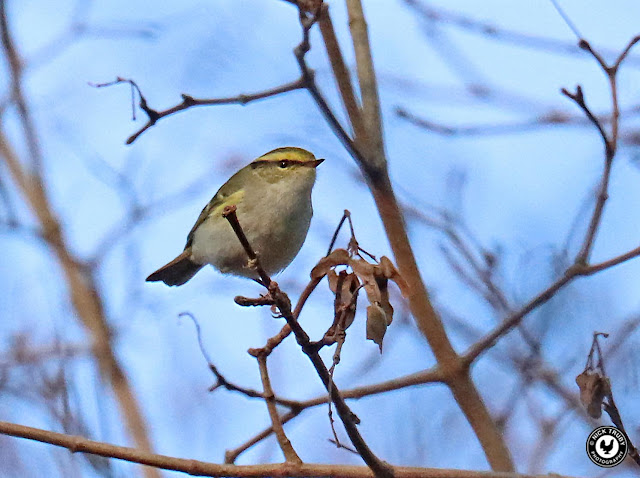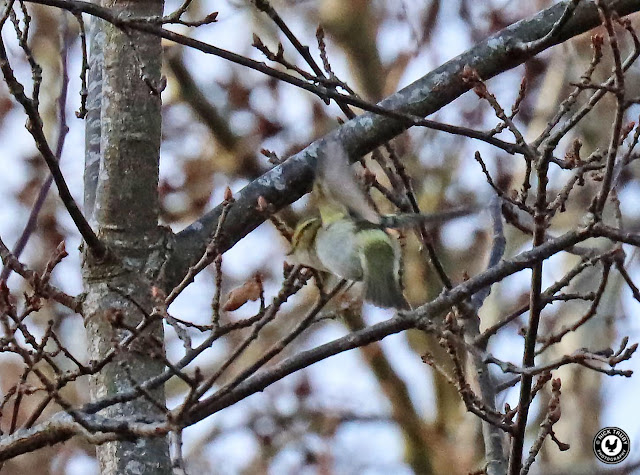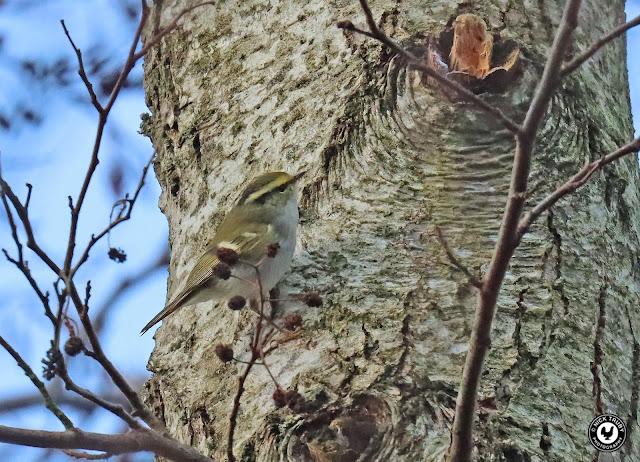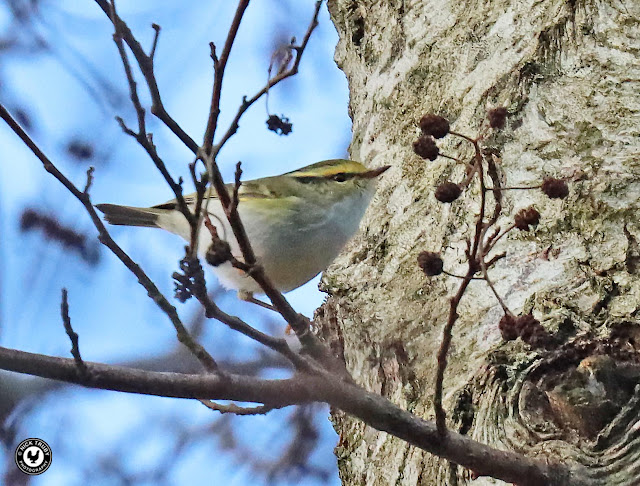In my last blog when writing about a Yellow-browed Warbler that was overwintering near Cambridge (read here) I suggested that one day somebody would find one wintering in Oxfordshire. Just a couple of days later that prophecy almost came true. Almost exactly in fact, except for one minor, but obviously very important detail. Dodgy and tenuous reworking of a Mary Poppins song title (sing it, it almost works) aside, the exciting discovery that Gareth Blockley made at Abingdon Sewage Water Treatment Plant late in the afternoon of Wednesday 5th January was the very closely related but even rarer Pallas's Warbler which was also amazingly a county first! Gareth reported the bird at quarter to four in the afternoon which was too late for any but those living, working or playing very closely to the works to get there before dark so for nearly every keen Oxon lister, Mrs Caley and myself included, it would be a nervy overnight wait before seeing if the Pallas's Warbler was indeed overwintering or had just been encountered passing through. For myself it also meant that if I was to go the next morning, which I simply had to, then I would have to concoct an excuse to duck out of work. My apologies to my clients and should they read this, then I hope they understand. Some things just have to be done. Then we stay happy (most of us anyway).
Thursday morning was forecast to be very cold and when we left home just after seven the car temperature gauge informed us that it was minus four degrees celsius on the drive. We intended to be on site at first light and start looking for the bird which surely would still be present. Only Mark and Badger had beaten us there but others were arriving and soon there would be almost forty of Oxon's finest on site. With so many expert eyes searching, the bird, if present, surely would not be missed. The Pallas's Warbler (PW) had been discovered in a hedgerow that forms a boundary to the Sewage works and the posse of birders lined the access track to begin the search. In the first hour or so it was still barely light and very little could be discerned in the tangle of bare branches. We chose to "work" our own little bit of the hedge and the tall trees on the other side of the lane. Like everyone else present, we wanted to be the ones that refound the PW, although on my past prowess that would be highly unlikely, even though I have refound a couple of overwintering PW's myself before, one in Dorset in 2016 and another in Durham in 2019 so there was a chance. Those two birds, both seen well, make up half of my previous sightings of Pallas's Warblers, the other two were seen in late October in Suffolk and Somerset. I never ever imagined that I'd be looking for one in my home landlocked county.
The first hour passed with no sign of the Pallas's warbler but birds were becoming active. The hedge was alive with Common Chiffchaffs and we kept ourselves warm by checking each one several times over as they flitted through the branches. Estimates of the numbers ranged from fifteen to fifty of these small warblers which are also overwintering at the site. The site is well known as a site for recording Siberian Chiffchaff, like the Pallas's Warbler a scarcer visitor from the east, and also reported by Gareth the day before. A Goldcrest in a fir tree behind us briefly raised excitement levels but by almost ten o'clock there was no sign of the rarer bird. People, ourselves included began wandering, looking at other places. We walked to the end of the lane where there was a small wood but ignored the area because a trio of dog walkers had congregated and were loudly conversing while their charges ran around untethered. Instead we checked the area by the works plant rear gates but found nothing. We returned to "our" spot and chatted to friends of our own while still scrutinising every small bird that we saw. Then it happened, Bark (the denizen of Otmoor and rarely seen away from there, it takes a county first to get him leave the place) answered a phone call. It was from another Otmoor regular, Pete Roby. He and Oz (Otmoor regular number three) had found the Pallas's Warbler and they had found it in exactly the same spot as we intended to search but were put off by the noisy dog lovers just fifteen minutes before. That is so typical of how my decisions pan out.
The news rippled through the crowd and we all frantically made our way to where Pete and Oz were. Unfortunately the PW had disappeared into a small stand of trees but at least we all knew that it was there and it was just a matter of time before it was seen again and we could all add it to our county lists. Pete found the bird again, this time in an alder tree that stood right next to the path. We trained our binoculars to the tree and there in the upper branches was the PW frenetically working its way from one twig to another, hovering frequently as it did so. The excitement and raised spirits amongst the birders was palpable. Seeing a rare bird stirs the same emotions that I used to feel when, back in my football supporting days, my team scored important goals. That instant hit of seeing a rare bird is one of life's great feeling. After watching it for a few seconds and after making sure that Mrs Caley had seen it, I tried to get a few record shots. A combination of the low light, the dense branches and my own poor efforts meant that I failed.
 |
| Pallas's Warbler |
The Pallas's Warbler flew over our heads and into a denser stand of trees and was lost to view again. It was on all of our county lists (my 237th, for the top listers the 274th!) and some birders with other things to do left but many of us wanted more. Luckily expert spotter Pete had remained and he found the PW again in a tree on the other side of the path. I locked onto it, followed it through the canopy and fired off some shots. Later inspection showed that I'd captured the bird but only parts of it, some photos were missing the head, others the body, all obscured my the branches of the trees. It was jokingly suggested that I create a collage of the body parts on view to get a composite and full image!
The bird disappeared again and we decided that we had withstood the freezing cold conditions for long enough and that it was time to go in search of coffee. I'd cajole Mrs Caley into coming back for another go at the PW in better and warmer conditions. On our way back along the lane towards the car we saw the mob of Common Chiffchaffs again in the hedge. I was struck by how pale one of them looked and thought that it may be one of the Siberian "tristis" types. It was fairly sedate for a Chiffchaff, tending to feed on the ground rather than in the branches of the bushes so was easier to see and follow. The tricky bit was getting an unobscured view through the chainlink fencing. After a few poor efforts I managed to do just that though and grabbed a couple of images. Oxon's county recorder and top birder, Lew, was stood a little way away so I showed him the back-of-camera image and asked if it was a tristis. He replied, "Oh yes!" and, "Where was it?" and then set about getting shots of his own. My mate and also expert birder Mick agreed that it was good for Siberian Chiffchaff. Good enough for me is that!
 |
| Siberian Chiffchaff |
As is my way, I spent much of Thursday evening and Friday morning wheedling away until Mrs Caley caved in and agreed to revisit the Pallas's Warbler the next day just as soon as it was confirmed as being there. That confirmation came mid-morning so we set off and arrived around eleven o'clock. I spotted The Early Birder's car parked up so gave him a quick call, he told us that the Pallas's Warbler was showing really well, "Hovering and everything" as we spoke. We strolled along the lane, much less frantic than the day before, to the wood, the same area where the PW had shown on our first visit. Another of our friends, Colin was there, and he looked at us ruefully and said the words that birders always hate to hear, "You should have been here a minute ago!" and "We've all just had great views of the Pallas's but it's gone now". For once though those words didn't hurt quite so much since we had seen it already and having had some experience of small Warbler species, I knew it would return soon because they tend to feed in a well worked and repeated circuit. It was less than ten minutes when somebody announced that it was back in the same trees as before. We left Colin at the path and made our way into the trees meeting more Oxon birders already there who had also come back for a repeat performance. Compared to the previous day the PW was much easier to see even though it was now in a denser part of the trees and stayed largely near the tops of them. I watched the PW for a while to get my eye in and made a couple of unsuccessful attempts at capturing it via the camera.
Now that I was following the Pallas's Warbler more easily and now that I was happy that Mrs Caley could see it as well, I put my efforts into photographing it. Pallas's Warblers move quickly, flitting from branch to branch and frequently hovering to snare insects. As I trained the camera skywards, it was thankfully a nicer day so there was more light under the trees, the bird suddenly dropped and appeared reasonably close to us assembled birders and photographers. Little did I realise until later, that the volley of shots that I took as the bird "performed" beautifully in front of us, would be the best that I'd manage over the next hour or so during which the PW was pretty much continuously on show.
The shot that everybody wants to capture is an in focus image of the Pallas's Warbler hovering and showing the yellow rump that is a diagnostic difference between it and the similar Yellow-browed Warbler. I never quite achieved that aim, despite the better conditions, shutter speeds were still too slow to prevent wing blurring and in any case trying to get my camera to sharp focus on such an energetic subject was impossible. I did capture the rump shot though when the bird settled briefly on a branch. I'm hoping that I'll be more successful when I take care of a new improved camera soon.
My other decent set of shots came when the Pallas's Warbler slowed down slightly for a few seconds and investigated a tree trunk. It still whirled around the tree at a good lick but occasionally steadied enough for a few reasonable frames. In any case I had achieved far better images than I'd ever got before of this enigmatic species. I was satisfied enough, for now, to happily walk away when the PW disappeared into the recesses of the wood again.
There were other good birds, especially in a year listing sense, seen during our hour in the wood although most were even more difficult to photograph owing to their habits of feeding right at the top of tallest trees. Siskins and Lesser Redpolls fed amongst a flock of Goldfinches on the alder fruits and a flock of Redwing alighted in the very tallest tree before flying off again. I turned my attention to a much easier to photograph Grey Wagtail that was feeding on the adjacent sports field in unison with around fifty Pied Wagtails and a score of Meadow Pipits.
 |
| Grey Wagtail |
We bade our goodbyes to the people we knew and made our way back to the car. I had some reasonable photos of the Pallas's Warbler and had enjoyed great views of it, so all felt good in the world. Back to work next week.
Super Pallas' is Fantastic, Exciting Phylloscopus!


















Brilliant write up mate
ReplyDeletegreat stuff Nick and a brilliant read - I might even go myself next week!!!!
ReplyDeleteVery nice Nick. I like the ones with it next to the tree trunk
ReplyDeleteGreat write up and pictures Nick, lovely bird and a pleasure too see.
ReplyDelete